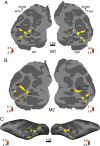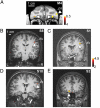Comparing face patch systems in macaques and humans
- PMID: 19033466
- PMCID: PMC2614792
- DOI: 10.1073/pnas.0809662105
Comparing face patch systems in macaques and humans
Abstract
Face recognition is of central importance for primate social behavior. In both humans and macaques, the visual analysis of faces is supported by a set of specialized face areas. The precise organization of these areas and the correspondence between individual macaque and human face-selective areas are debated. Here, we examined the organization of face-selective regions across the temporal lobe in a large number of macaque and human subjects. Macaques showed 6 regions of face-selective cortex arranged in a stereotypical pattern along the temporal lobe. Human subjects showed, in addition to 3 reported face areas (the occipital, fusiform, and superior temporal sulcus face areas), a face-selective area located anterior to the fusiform face area, in the anterior collateral sulcus. These results suggest a closer anatomical correspondence between macaque and human face-processing systems than previously realized.
Conflict of interest statement
The authors declare no conflict of interest.
Figures



References
-
- Darwin C. The Expression of the Emotions in Man and Animals. London: John Murray; 1872.
-
- Nelson CA. The development and neural bases of face recognition. Infant Child Dev. 2001;10:3–18.
-
- Moscovitch M, Winocur G, Behrmann M. What is special about face recognition? Nineteen experiments on a person with visual object agnosia and dyslexia but normal face recognition. J Cognit Neurosci. 1997;9:555–604. - PubMed
-
- Yin R. Looking at upside-down faces. J Exp Psychol. 1969;81:141–145.
Publication types
MeSH terms
LinkOut - more resources
Full Text Sources
Medical

